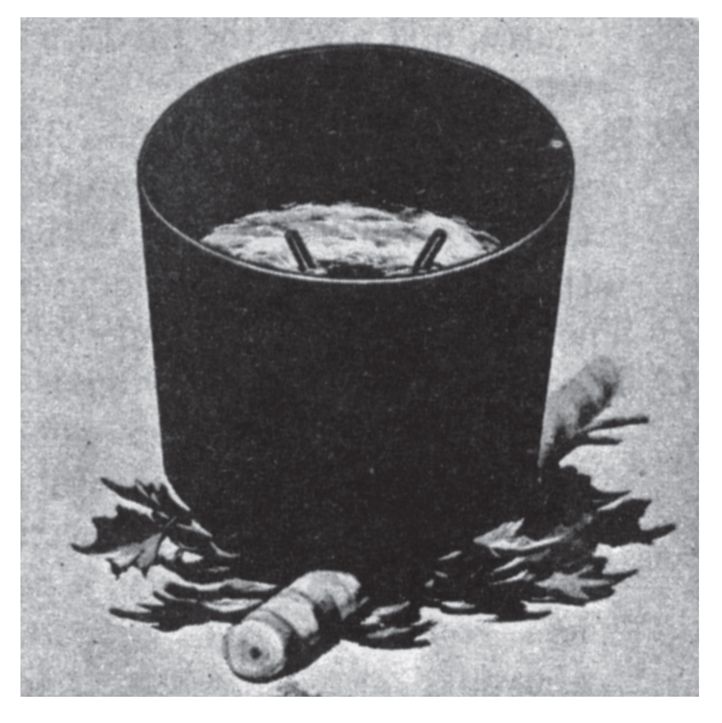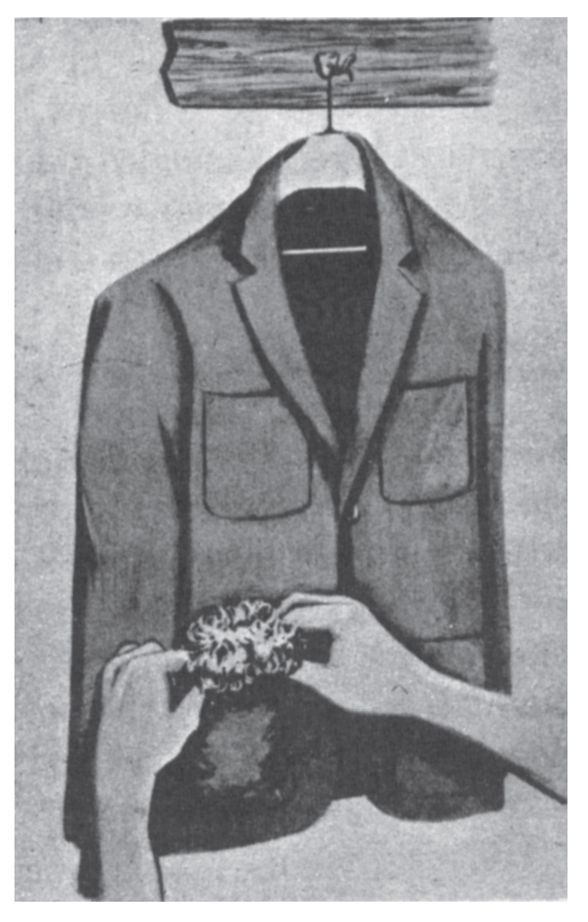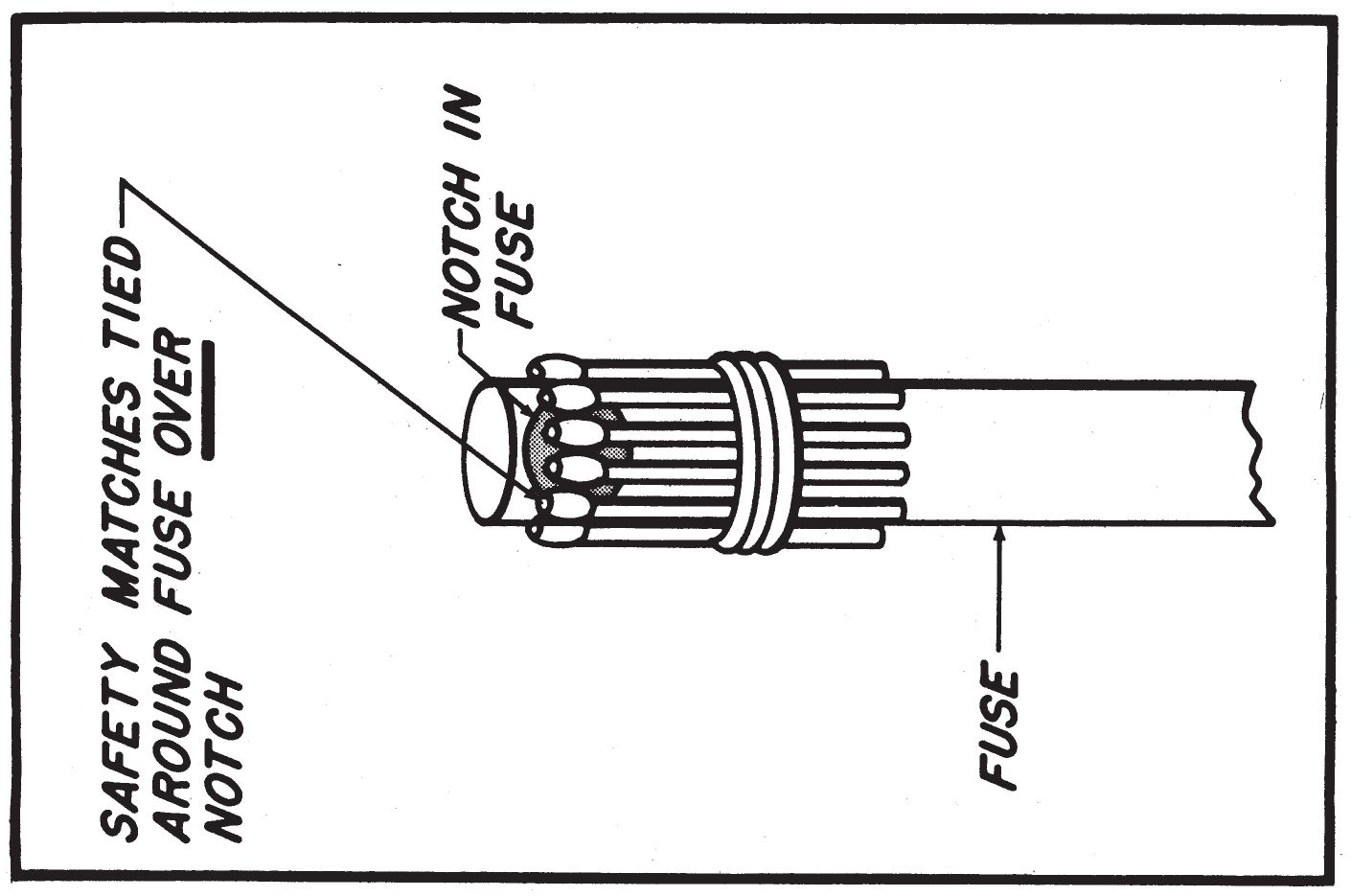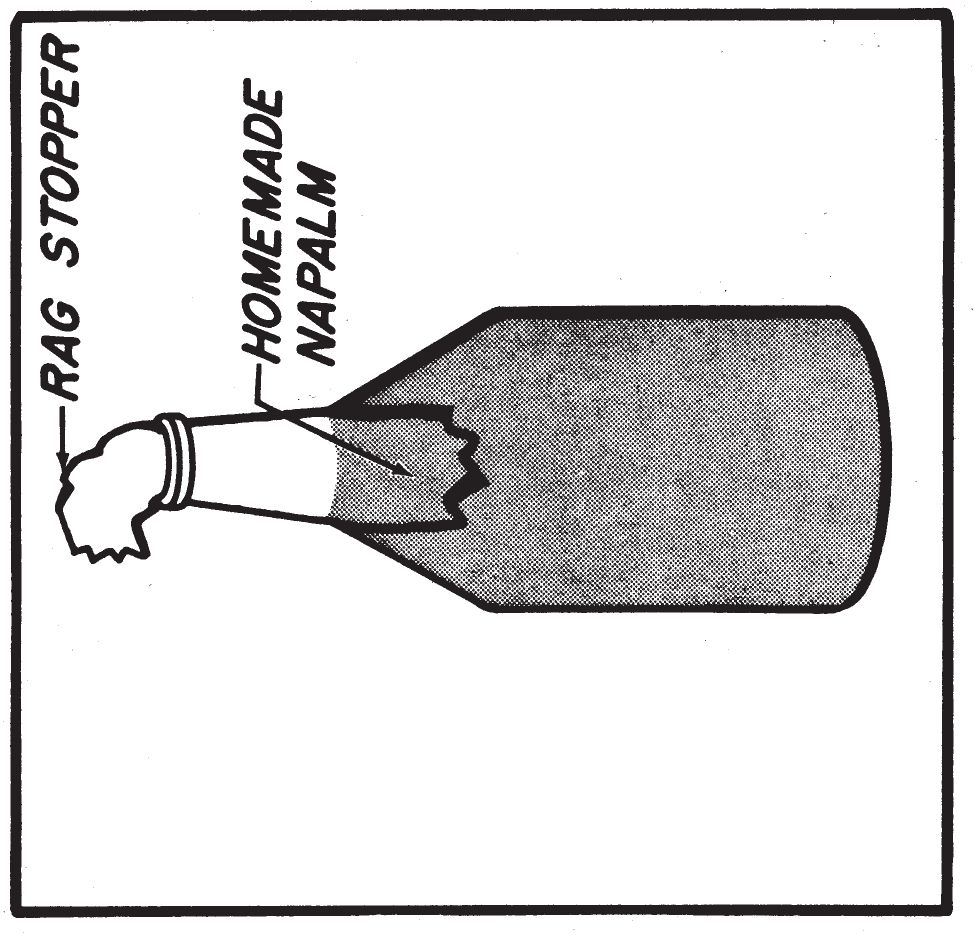Read U.S. Army Special Forces Guide to Unconventional Warfare Online
Authors: Department of the Army
U.S. Army Special Forces Guide to Unconventional Warfare (14 page)

d. Application.
- The spontaneous combustion device is placed at the target on a flat surface with one edge propped up to allow ventilation through the impregnated combustible material.

Since flames normally shoot up from the open top of the container, combustible target material should be positioned from three to five inches directly over the top of the device for satisfactory ignition of the target.
DO NOT COVER OPEN TOP OF CONTAINER
. - Temperature of the environment in which these devices are used affect, the ignition time these devices are used affects the ignition time. The following table gives approximate time to ignition at different temperatures. However, it is recommended that ignition time be determined by advance trial.
Temperature
(°
F.
)Time to ignition
(
hours
)60-70 1-2 40-60 2-4 30-40 4-10 - Spontaneous combustion devices can also be improvised by stuffing impregnated combustible material into a pocket of any one of the following garments: coat, laboratory jacket, pants, or similar items. The combustible material stuffed in the pocket should be below the top of the pocket and should not be packed too tight.

Alarm clock delay 0412
Alcohol:
Incendiary 0308
Lye thickeners for gasoline 0303.1 to 0303.3
Soap thickener for gasoline 0303.4
Aluminum powder igniter mixes 0204, 0207
Animal blood thickener for gasoline 0303.8
Balancing stick delay 0410
Balsam-lye thickener for gasoline 0303.3
Barium peroxideâmagnesium powder igniter. 0210
Blasting time fuse 0101
Brick, incendiary 0309
Candle delay 0406
Chemical hazards 0303
Chemical materials. (See specific materials, thickeners.)
Cigarette delay 0401
Cobalt drier 0501
Combustible materials 0501
Corrosive action delay 0409
Definitions 0002
Delay mechanisms. (
See also
specific item.) 0306, 0401 to 0412
Diaphragm delays 0403,0404
Dissolving action delay 0409
Egg thickener for gasoline 0303.5
Fire:
Bottles 0305,0306
Fudge igniter 0202
Hazards 0003
Flammable liquids 0308
Fuse:
Cords 0101,0102
Lighter, M2 0101
Lighter, M60 0101
Gasoline incendiaries 0302, 0303, 0308
Gelatin capsule delay 0402
Gelled gasoline incendiaries 0302, 0303
Glycerin delays 0405,0407
Glycerinâpotassium permanganate igniter.0206
Igniters. (See also specific item.) 0201 to 0211
Incendiary:
Brick 0309
Materials. (See also specific item.) 0301 to 0309
Systems 0001
Initiators.
(See
also specific item.) 0101 to 0104
Latex thickener for gasoline 0303.6
Lead drier 0501
Linseed oil 0501
Lye thickeners for gasoline 0303.1 to 0303.3
Magnesium powder igniter mixes 0208, 0210
Match head igniter 0205
Napalm incendiary 0301
Oil of vitriol initiator 0103
Overflow delay 0407
Paper diaphragm delays 0404, 0405
Paraffin-sawdust incendiary 0304
Potassium:
Chlorate-sugar igniter 0201
Permanganate crystals delay 0405
Permanganateâglycerin igniter 0206
Rubber band delay 0411
Rubber diaphragm delay 0403
Safety Fuse, M700 0101
Safflower oil 0501
Silver nitrateâmagnesium powder igniter. 0208
Soap-alcohol thickener for gasoline 0303.4
Sodium:
Chlorate-sugar igniter 0201
Peroxideâaluminum powder igniter. 0204
Peroxideâsugar igniter 0203
Spontaneous combustion 0501
String fuse 0102
Subigniter for thermite 0211
Sugar igniter mixes 0201,0203
Sulfur pelletsâaluminum powder igniter. 0207
Sulfuric acid delays 0402 to 0404
Sulfuric acid initiator 0103
Thermite igniter 0211
Thermite incendiary 0307
Thickeners for gasoline. (See also specific material.) 0302, 0303
Tipping delays 0408 to 0410
Tools and techniques. (See also 0003 specific device.)
Tung oil 0501
Water delays 0402,0407 to 0409
Water initiator 0104
Wax thickener for gasoline 0303.7
White phosphorus igniter 0209
HAROLD K. JOHNSON,
General, United States Army,
Chief of Staff.
Official:
J. C. LAMBERT,
Major General, United States Army,
The Adjutant General.
* U. S. GOVERNMENT PRINTING OFFICE : 1967 O - 300-528 (7016C)
Good incendiaries can be improvised more easily than explosives and the materials are more easily obtained. On a pound for pound basis, incendiaries can do more damage than explosives against many type targets if properly used. There is a time lag, however, between the start of a fire and the destruction of the target. During this period the fire may be discovered and controlled or put out. An explosive once detonated has done its work.
Incendiaries are cheap and little training is needed for their preparation and use. Used in very carefully excuted operations, the act of sabotage may be concealed in the ashes of an “accidental” fire.
Fires may be started quickly and have reasonable chance of success if the following few simple principles are observed:
1. See that there is plenty of air and fuel to feed the fire.
2. Use an incendiary that supplies a prolonged and persistent heat.
3. Start the fire low in the target structure and let it spread naturally upwards.
4. Use reflecting surfaces, such as corners, boxes, shelves, to concentrate the heat.
5. Use drafts to spread the fire rapidlyânear stairways, elevator shafts.
6. Protect the fire from discovery during the first few minutes by good concealment and timing.
In preparing improvised incendiaries observe basic rules of safety. Chemicals that must be powered should be ground separately with clean tools and then mixed in the indicated proportions. Chemicals or mixtures should be kept tightly sealed in jars or cans to protect them from moisture. Damp materials will work poorly if at all.
Sulfuric acid, which is useful for chemical delays and to ignite incendiaries or explosive detonators, can be obtained by concentrating battery acid. This can be done by boiling off the water in the battery acid in a glass or porcelained pan until dense white fumes begin to appear. This operation should be done out of doors and the resulting concentrated acid should be handled carefully.
The paragraphs which follow will describe the preparation of several igniter (or “first fire”) incendiary mixes, some basic incendiary mixes, and a thermate metal-destroying incendiary.
The subject of incendiaries has been treated much more exhaustively in other publications. The intent of this handbook is to provide only a few techniques.
Chlorate-sugar is one of the best of the first fire or igniter mixes. It burns very rapidly, with a yellow-white flame, and generates sufficient heat to ignite all homemade incendiaries mentioned in this handbook.
MATERIALS: Potassium chlorate (preferred) or sodium chlorate, sugar.
PREPARATION:
1. Grind the chlorate separately in a clean, non-sparking (glass or wooden) bowl with a wooden pestle. the resulting granules should approximate those of ordinary table sugar.
2. Mix equal volumes of the granulated chlorate and sugar by placing both on a large sheet of paper and then lifting the corners alternately.
CAUTION: This mixture is extremely spark sensitive and must be handled accordingly.
3. Wrap 4 to 6 tablespoonfuls of the mixture in thin paper so as to form a tight packet. Keep the mixture as dry as possible. If it is to be stored in a damp area before using, the packet may be coated with paraffin wax.
Chlorate-sugar is easily ignited by the flame of a match, the spit of a percussion cap or time fuse, with concentrated sulfuric acid.
If ignited when under confinement it will explode like gunpowder. If it is contained in a waxed packet, therefore, the latter should be punched through in several places before it is used with a basic incendiary and ignited.
This simple igniter burns extremely hot and will ignite even the metal-destroying thermate, described later on. The mixture itself can be lit by chlorate-sugar.
MATERIALS: Flake aluminum, finely powdered sulfur.
PREPARATION:
1. Mix 4 parts by volume of finely powdered sulfur with 1 part of aluminum powder.
To use, place several spoonfuls of the mixture on the material to be lit and add a spoonful of chlorate-sugar on top. Be sure the safety (time) fuse or other spark-producing delay system is placed so it will act upon the chlorate-sugar mixture first.
Black powder may be used for igniting napalm, flammable solvents in open containers, paper, loose rags, straw, excelsior and other tinder type materials. If it is not available already mixed, it can be prepared as follows:
MATERIALS: Potassium (or sodium) nitrate, powdered charcoal. powdered sulfur, powder
PREPARATION:
1. Into a clean, dry jar or can put 7 spoonfuls of potassium or sodium nitrate, 2 spoonfuls of powdered charcoal, and 1 spoonful of powdered sulfur. The ingredients must be at least as fine as granulated sugar. If they must be ground, GRIND EACH SEPATATELY. Never grind the mixed ingredientsâthey may ignite or explode.
2. Cap the can or jar tightly and shake and tumble it until the ingredients are completely mixed.
The mixture will be effective for months if kept tightly sealed and dry. Sodium nitrate in particular has a tendency to absorb moisture.
To use the gunpowder, pile 2 or 3 spoonfuls on top of any solid incendiary material which is to be ignited. For igniting liquids in open containers, wrap 2 or 3 spoonfuls in a piece of paper and suspend it just above the liquid.
Gunpowder is best ignited by safety fuse. It burns very quickly and with a great deal of heat, so allow sufficient time delay for safe withdrawal from the vicinity.
A good ignition material for incendiaries can be obtained from the heads of safety matches, which are available almost any place. The composition must be removed from the heads of many of them to get a sufficient quantity of igniter material. It will ignite napalm, wax and sawdust, paper, and other flammables.
MATERIALS: Safety matches.
PREPARATION:
Remove the match head composition by scraping with a knife or crushing with pliers. Collect several spoonfuls of it and store in a moisture-tight container.
Put at least 2 spoonfuls on the material to be ignited. To ignite liquids, such as solvents or napalm, wrap several spoonfuls in a piece of paper and hang this just over the fluid, or place nearby. If fluids dampen the mixture it may not ignite.
Ignition can be by time fuse, fircracker fuse, a spark, or concentrated sulfuric acid.
Several igniters or first fire mixes can be set off by a spark from time fuse. Others require a stronger flame. Time fuse, plus matches, can be combined to improve this more intense initial flame.
MATERIALS: Time (safety) fuse, safety matches, string or tape.
PREPARATION:
1. About ¼ inch from the end of a piece of time fuse cut a notch with a sharp knife so that the powder train is exposed.
2. Around the fuse at this point tape or tie several matches so that their heads are in contact with each other and at least one match head is directly over the notch. See
Figure 59
.
When the fuse burns down, a spark from the notch ignites the one match head, which flares and ignites the others. this fire starter can be inserted into an igniter mix or used alone to light crumped paper or excelsior. Another application, nonelectric firing of the 3.5” rocket, is described earlier.
Napalm is the best incendiary to use against most flammable targets. It will readily ignite paper, straw, flammable solvents, or wooden structures.
MATERIALS: Gasoline or fuel oil, nondetergent soap (bar, flakes, or powder).
PREPARATION:
1. Use about equal parts of soap and oil. If bar soap is used, slice it into small chips. If both gasoline and fuel oil are available, use both in equal parts.
2. Heat the fuel in an open container, preferably one with a handle, out of doors. Try to avoid creating sparks or having a high open flame, but if the fuel should catch on fire extinguish it by placing a board or piece of tin over the container.
3. Gasoline, in particular, will begin to bubble very quickly. When it does, remove from the fire and gradually add the soap, stirring continuously, until the soap is completely dissolved and a thin pasty liquid results. If necessary return the mixture to the fire, but as a safety measure it is best not to stir while the container is on the fire.
4. When the desired consistency is reached allow the mixture to cool.
5. Napalm also can be mixed by a cold method, although it may take hours to thicken. This should be done by alternately adding very small amounts of soap chips or powder and gasoline or fuel oil and stirring until the mixture reaches a thin jelly-like consistency. It is best to start with about a cupful of soap, add part of a cup of solvent and stir that until smooth before gradually adding the remaining ingredients. Continuous stirring is not required. In fact, it is advisable just to let the mixture and the mixer rest from time to time and give the soap a chance to dissolve.

Fig. 59
âTime Fuse Fire Starter

Fig. 60
âMolotov Cocktail
Napalm will keep well if stored in a tightly sealed container. It can be ignited with a match or any of the first fire mixtures described previously. The ignition packet should be placed adjacent to or just over the napalm, otherwise the petroleum may soak it and prevent its burning.
When napalm is used on easily ignitible materials (such as loosely piled paper, rags, or hay) it should be spread out so it will start a large area burning at once. Tightly baled paper or rags should be loosened first, because they do not burn well. If used directly against wooden structures or other large articles which are diffcult to ignite, the napalm should be concentrated in sufficient quantity to provide a hot, long lasting blaze. If about a half dozen pieces of charcoal are put into and around the napalm the heat output is considerably increased.
Napalm makes an excellent “Molotov cocktail.” Just fill any glass bottle with a small neck with the napalm and cram a twisted strip of cloth into the mouth of the bottle as a stopper. See
Figure 60
. When ready to use, pull about 4 to 6 inches of the rag stopper out of the bottle. Light the napalm-soaked rag with a match and, when the rag is burning well, throw the bottle at the target. When the bottle breaks napalm spashes over the target and is ignited by the burning rag.
Paraffin-sawdust is almost as effective as napalm against combustible targets, but it is slower in starting. It is solid when cool and thus is more easily carried and used than liquid napalm. In addition, it can be stored indefinitely without special care.
MATERIALS: Dry sawdust, paraffin, beeswax, or candle wax.
PREPARATION:
1. Melt the wax, remove the container from the fire and stir in a roughly equal amount of sawdust.
2. Continue to stir the cooling mixture until it becomes almost solid, then remove from the container and let it cool and solidify further.
Lumps of the mixture the size of a fist are easiest to manage. The chunks of incendiary may be carried to the target in a paper bag or other wrapper. Any igniter that will set fire to the paper wrapper will ignite the wax and sawdust.
A similar incendiary can be made by dipping sheets of newspaper into melted wax and allowing them to cool. These papers may then be crumpled up and used in the same manner as the paraffin-sawdust, although they will not burn as hot and persistently.
